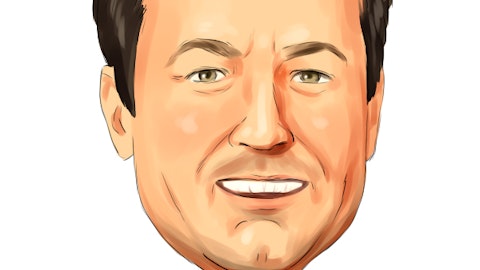Performant Financial Corporation (NASDAQ:PFMT) Q3 2023 Earnings Call Transcript November 7, 2023
Performant Financial Corporation beats earnings expectations. Reported EPS is $-0.01, expectations were $-0.02.
Operator: Good afternoon, ladies and gentlemen and welcome to the Performant Financial Corp. Third Quarter 2023 Earnings Conference Call. [Operator Instructions] This call is being recorded on Tuesday, August 8, 2023 [ph]. I would now like to turn the conference over to Jon Bozzuto, Head of Investor Relations. Please go ahead.
Jon Bozzuto: Thank you, operator. Good afternoon, everyone. By now you should have received a copy of the earnings release for the company’s third quarter 2023 results. If you have not, a copy is available on the Investor Relations portion of our website. On today’s call will be Simeon Kohl, Chief Executive Officer; and Rohit Ramchandani, Chief Financial Officer. Before we begin, I’d like to remind you that some of the comments made on today’s call, including our financial guidance, are forward-looking statements. These statements are subject to risks and uncertainties, including those described in the company’s filings with the SEC. Actual results may differ materially from those described during the call. In addition, all forward-looking statements are made as of today and the company does not undertake to update any forward-looking statements based on new circumstances or revised expectations.
Also, all non-GAAP financial measures discussed during this call are reconciled to the most directly comparable GAAP measures in the table attached to our press release. I would now like to turn the call over to Simeon Kohl. Sim?
Simeon Kohl: Thank you, Jon. Good afternoon, everyone and thank you for joining us for our earnings call. During the third quarter of 2023, we continue to see our vision as a pure-play health care organization come to fruition. We are driven by a singular purpose and that is to transform the health care ecosystem by addressing over $300 million in Payment Integrity waste. Our mission is to partner with payers to develop innovative solutions that redirect these funds towards enhancing patient care and well-being. This past quarter, that translated into successful completion of another 12 commercial implementations while contributing strong top and bottom line growth. One of the key reasons for our success has been our ability to attract and retain top talent.
We shifted our culture and values as we transition from a debt recovery business to a health care organization, taking care to share our corporate vision which has attracted the best in the business. Our roster now includes experienced leaders from large national payers, government programs, health care providers and other health care-focused technology organizations. The galvanizing quality amongst this team is the desire to make a difference. We’ve all personally witnessed this waste and we understand that by strategizing and reducing it, we can significantly redirect these funds toward improving patient care. Our team has forged strong partnerships as our mission resonates with the broader health care community. In the third quarter, we had the pleasure of presenting alongside Priority Health to highlight the value of performance partnership with CAQH.
As a reminder, the partnership with CAQH gives Performant access to extensive eligibility data which supplemented with our proprietary data and services, provides differentiated value and more material ROI for our mutually supported clients. Building on our client-centric approach, in the third quarter, we hosted Performant’s second Customer Advisory Board. This Board was established to connect key clients with peers to facilitate discussions on common pain points and create actionable solutions. This 3-day meeting was incredibly successful with increased engagement and feedback, such as hearing about how pain points of other health plans gave for participants momentum to move internal health plan initiatives forward. We are proud of the partnership we have built with industry leaders and clients and much of that success hinges on our results-driven team.
This approach has led to a strong sales pipeline. In the third quarter, we completed 12 commercial implementations, bringing our 2023 total to date to 34 compared to 21 implementations in all of 2022. This feat could not be achieved without instituting significant operational rigor into our implementation process. As we shared on previous calls, 1 of our initiatives is to improve efficiency and reduce the time to market for our implementations. You can see through the first 3 quarters, we have performed well. The greater efficiency that we drive toward our path to revenue, the more we can focus our resources on scaling and innovating. Our sales strategy has been focused on growth in the commercial market as we estimate that well over half of Payment Integrity waste lies within managed care organizations.
Our success within these commercial markets continues to be evidenced by our strong cadence of implementation. One of many effective strategies has been to target commercial clients in jurisdictions where we already have a government presence. Our government presence has been our long-standing backbone as we manage 3 of 5 CMS RAC regions, the Health and Human Services OIG contract and the CMS Medicare secondary payer CRC contract. Looking holistically at our government business, we have a strong federal presence in both claims and eligibility-based services. In early October, we announced our first state Medicaid win, further bolstering our government backbone. The New York State Medicaid recovery audit contract was awarded based on an open and competitive RFP process.
Performant demonstrated that it would deliver the best value and quality and a key catalyst to us winning this contract was our ability to consistently perform and innovate for our long-standing federal government partners. It should be noted that the incumbent vendor has filed a protest. And as a result, the New York State OSC will render a determination on the protest in the coming months. We have experience working through similar situations as earlier this year, CMS affirmed their decision to choose Performant as their RAC Region 2 contractor after a protest from the incumbent vendor. Similar to RAC Region 2, we will actively engage in the protest to validate New York State’s decision that Performant drives the best overall value for the state’s Medicaid RAC program.
We are very excited about this win and the opportunity to prove ourselves in the state Medicaid market. Looking at the macro landscape, we have 2 impactful trends to address. First is the end of the public health emergency as of May 11 of this year; and the second is the continued uptick in normalization of health care utilization. During the PHE, CMS restricted us from requesting claims with a COVID-19 or certain other related codes such as those with a respiratory designation. The end of this emergency now gives us the ability to select claim codes previously restricted by the PHE that we believe contain a payment error. There was a chance we get a look back at claims that were historically excluded during the PHE itself. However, that does not seem likely at this stage.
The normalization of health care services and costs is another macro tailwind as we’ve seen many for-profit payers and providers report that health care utilization has normalized as elective procedures have returned and pricing has begun to catch up to the cost structure. We have also seen a shift towards outpatient procedures. These macro trends bode well for us as the majority of our revenue is predicated on contingency fees of client savings that we identify. As cost of services increase, Performant’s savings dollars and associated contingency fees should also increase. Additionally, many of our audit products support outpatient procedures, neatly aligning us with these macro trends. Turning to our results. Health care revenues in the third quarter of 2023 grew 21% year-over-year, mainly driven by our commercial clients.
Our eligibility-based revenue grew 38% as new clients and contracts ramped. In particular, we saw significant growth in our commercial clients as our mature government contract was a drag in the overall eligibility growth rate. Our claims or auto-based revenue was flat in the quarter. The government relationships were a drag on the performance due to the impacts from the PHE. There are 2 factors at play here. First, looking at the comparable prior year period, although we were unable to audit more recent restricted claims, we enjoyed the benefit of the 3-year lookback. This means we are able to audit those restricted claims that had dates of service prior to the PHE. In the current year, that 3-year look-back funnel has become non-existent which drives a more difficult year-over-year comparison.
This is further exacerbated by the timing ramp. By way of example, for available claims that had a date of service on May 12, we wouldn’t be able to see and request those claims until July at the earliest to then go through the audit and validation process before any revenue could be recognized. We believe we will start to see this revenue normalize towards the end of the fourth quarter. On a positive government note, EMS RAC Region 2 is now operational and began to generate revenue in the third quarter. We were able to implement this contract incredibly quickly as we commenced work in November of last year and we are already generating initial revenues. Our speed to market has become a competitive differentiator as we prove our clients’ ROI thesis.

Once again, in our claims-based business, commercial led the way as contracts ramp and efficiency gains took shape. For instance, when working with more seasoned clients, we often employ the analogy of evaluating adapting the factory’s workflow. Even if a particular workflow has been in place for years, we aim to approach it with a fresh perspective, seeking opportunities to enhance the overall efficiency. We undertook this process earlier in the year for a select group of larger audit-based clients and we are already witnessing the dividend it pays through the optimization of workflows, data feeds and client collaboration and communication. In aggregate, despite some of the short-term macro impacts of our government work, we are encouraged by the growth prospects for these contracts.
Government contract service performance backbone given their size, visibility and extended term, they also bolster our credibility when selling to commercial clients. Before I hand the call off to Rohit to go over the results of the quarter, I wanted to reiterate how proud I am of our team. We have made the transition to a pure-play health care organization while navigating the dynamic COVID-19 landscape. The investments we’ve made to build our talented workforce and streamline processes are yielding substantial return, enabling us to not only foster new business opportunities but also execute on existing client expansion. With that, I’ll hand it over to Rohit Ramchandani, our Chief Financial Officer, for a discussion of our financials. Rohit?
Rohit Ramchandani: Thanks, Sim. As Sim shared, we are excited about these new business plans and our execution on existing business. Our pure-play health care strategy continues to bear fruit as we grow these revenues, especially with our commercial clients. We did see some sluggishness in our government accounts but do not expect those to continue as we believe macro trends will swing in our favor. This is in addition to ramping CMS RAC Region 2 alongside being awarded the New York State Medicaid RAC contract. We remain confident in our overall strategy toward achieving our long-term goals. With that, let’s dive into the quarter’s results. Our results in the third quarter of 2023 reflect our successful efforts to scale our operations.
Total company revenues in the quarter were $30 million which included health care revenues of $28.5 million, setting yet another Performant record for quarterly health care market revenues. Our customer care outsourced services business accounted for $1.5 million of revenue during the quarter, a decline of 2.1 from last year which is in line with our expectations for this business. Federal student loan repayments officially restarted on September 1 and we are seeing positive volume demands associated with this restart. We expect these revenues to grow moderately next year and could show potential beyond that depending on sustained demand. As a reminder, while our strategic focus remains on the health care markets, this business does generate a positive contribution margin with limited distraction.
We understand that stand-alone companies in a similar space operate with single-digit margins and would expect the same from our work. Revenue from our eligibility services within health care for the third quarter were $18.2 million, representing an increase of roughly 38%. As Sim mentioned, commercial climate led the way. New client limitations showed well and frankly, ahead of expectations with some revenue pull forward from the fourth quarter results. We also performed well with existing clients as they continue to scale our services, benefited from the continued diversification of our offerings and enjoy the quality of our data with our purpose-built technology platform. We expect that these positive results to continue with our commercial clients as we feel we have a best-in-class offering and our implementation cadence supports that.
Within our claims base business, also known as claims auditing, revenues in the third quarter of 2023 were $10.3 million which was roughly flat year-over-year. Commercial operations continued to perform well as existing implementations scaled in line with our expectation and we achieved significant efficiency gains. As Sim mentioned, our existing government auditing contracts were impacted by macro factors related to PHE which created a difficult year-over-year comparison. We currently do not expect these factors to persist beyond the current year as the PHE limitations are behind us. In addition to the macro types turning, we have 3 positive long-term growth drivers on the government side. First is the quick implementation of CMS RAC Region 2.
As Sim mentioned, we generated initial revenues for this contract in the third quarter and we expect volumes to continue to grow and eventually hit steady state in late 2025. Second, our contributions from the HHS OIG contract. This contract is project-based. And while we have completed some initial projects, we are just kicking off a true growth trajectory for this relationship. And finally, our recent win for the State of New York Medicaid RAC contract. Once the protest review process plays out and as a result and assuming we are awarded the final contract, we expect to gain a better understanding of the implementation pipeline and cadence to ramp the audit volume. This information will help us to better project revenue and contribution margin for the years to follow.
In addition to these government catalysts, we implemented 12 new commercial opportunities in the third quarter. This brings us through the first 9 months to a total of 34 commercial client implementations, approximately half are new and half with existing clients who are adding services and expanding scope. We estimate that these 34 implementations will drive approximately $16 million in annualized revenues at steady state. The unit-level economics of these contracts generally mean that we are operating negative margins in the first year, the second year we are breakeven and in the third year, we are at positive contribution margins. We believe that these commercial implementations plus the backbone provided by our government contracts, set us up well for long-term sustained growth.
Our ambitious growth plans are supported by capital infusion and I’m delighted to state that our refinance of our previous credit agreement is now complete. Wells Fargo has shown strong commitment by offering a $25 million revolving credit facility. This restructure alleviates specific onerous covenants and allows us to manage our business with greater flexibility. We have significant opportunity and momentum in the health care payment integrity space and the flexibility provided under our new credit agreement allows us to continue to pursue sizable client wins. We are confident that we have the capital structure in place to support our short-term cash needs while balancing the long-term growth of this business. Shifting to operating expenses.
These represented $30.6 million in the third quarter or $1.1 million higher compared to the third quarter of last year. It was primarily driven by increasing head count and salaries to support the record number of implementations in 2023. This is great for the long-term growth trajectory, though it does initially impact margins. Our adjusted EBITDA for the quarter was positive $1.8 million or approximately $2.1 million ahead of the prior year. This was slightly ahead of expectations as we saw the benefit of some of the eligibility revenue pulled forward but ultimately reflective of continued scale. We anticipate the health care business to experience its typical seasonality as we continue to drive sequential revenue and EBITDA growth in 2023.
We maintain our strategy to grow margins through scale and efficiency gains. To give you an example of an operational efficiency initiative, we recently instituted an extra layer of analytics and natural language processing into our chart selection and review process through a subset of our claims auditing work. This process accomplishes 2 things. First, we have a better hit rate on the charts ultimately selected and reviewed; and secondly, nurses and claim reviewers are able to expedite their review processes to review additional claims each day. We feel confident reiterating our guidance for 2023 health care revenues to the range of $105 million to $110 million, full company revenue between $111.75 million to $118 million and for the full year 2023 adjusted EBITDA to be in the range of $2 million to $5 million which reflects our ongoing investment and growth initiatives, alongside improved operational efficiencies.
Given where we are in the year, we do have stronger visibility into achieving the lower to midpoint of the range. But given some of the external factors that have influenced our business both upward and downward, we are maintaining the broader range of possibilities. Our primary goal remains the long-term expansion of both revenue and EBITDA. If you had told me 2 years ago that our most significant challenge would be executing a new CMS RAC region as well as our first state Medicaid win on top of our continued successful commercial growth plans, I would have found it hard to believe. Over the past 3 years, it has truly been remarkable to see our strategic wins and expanding our market presence. Now our primary focus is the continued expansion of that presence and evaluating opportunities for enhancing our efficiency, particularly within our workflow processes.
I am pleased with our results as we delivered a solid quarter of financial and operational performance, reflecting the strength of our healthy and diversified business mix. Operator, will you please open up the lines for questions?
Operator: [Operator Instructions] Our first question is from George Sutton of Craig Hallum.
See also Top 15 Independent Oil and Gas Companies in the World and 15 Large Cap Stocks Hedge Funds are Dumping.
Q&A Session
Follow Performant Financial Corp (NASDAQ:PFMT)
Follow Performant Financial Corp (NASDAQ:PFMT)
George Sutton: Nice to see the results. So I wondered if we can have a broader Medicaid state RFP discussion. We’ve obviously seen 2 awarded. We’ve got 1 coming next month in Texas. Can we talk about how other states look? And this is obviously a trend that has begun and it’s seemingly in your favor. Just wanted to make sure I understood what your expectations are for Medicaid RFPs over the next 12 to 18 months.
Simeon Kohl: George, it’s Simeon. Look, it’s a bit hard to determine. I think to your point, we have certainly seen some positive momentum in terms of the states recognizing that they really need to focus on their cost containment initiatives. I think there’s been some pressure from CMS and HHS and OMV that, that needs to happen. There’s been some waivers that have been expiring and there’s been some oversight that suggest that the states could do a better job with their RAC-based initiatives. And so we’re excited about that. We think that obviously parallels well with our efforts into the space and with the recent win. Our teams are trying to understand timing. It’s just a little bit hard to predict. As you stated, there’s one currently out there right now for an RFP that we’re participating in. But I think safe to say, with the win in New York State, we are super excited about our prospects to leverage that as we think about other opportunities.
George Sutton: Now New York State was awarded in 3 parts. You won 1 of those parts. And the protest participants won the other 2 pieces, if I believe correctly. Do they put the entirety of that award back up on the shelf for the protest? Or is it simply the piece here? And coincidentally, I assume you have not done a protest on the eligibility piece that you were not part of.
Simeon Kohl: Correct, correct on both fronts. The protest only relates to the RAC award that Performant won and Performant did not pursue any other protests with the procurement broadly.
George Sutton: So one other question on the RAC Region 2. As you’re — you’ve gone through the process implementation there. And as you go out into those states that from a commercial perspective where you now are connected to all the payers, can you just talk about the opportunities that you’re seeing that may not have existed before you had all that connectivity and presence in those states?
Simeon Kohl: Yes. Look, we’ve talked about this. I’ve said it in my prepared remarks. The backbone of our business is that relationship, the broad relationship we have with CMS. As we think about the spend and what CMS controls of that $4.3 trillion spend and 1/3 of it runs through CMS either through the fee-for-service programs or through their contribution to managed care or managed Medicaid programs, clearly, our partnership with CMS and now HHS and obviously, now the state, it really resonates with the commercial plans. And so we have seen great success in our original award of RAC Region 1. We’ve seen success in terms of how we leverage that in that particular jurisdiction, being able to talk to some of the payers in that region, let them know that we have good visibility to policy from CMS.
We’re closely aligned. We have significant investment in that jurisdiction and understanding provider behaviors, etcetera. So similar to how Medicare Advantage plans, recognized performance, value and experience with the CMS, we feel the same in terms of Medicaid managed care plans and how they closely align with Medicaid agencies. And so we anticipate that we’ll see the similar value and they’ll recognize similar value, if you will and our expanding Medicaid experience and especially those plans located in New York. So net-net, we continue to use that as 1 of our key go-to-market strategies from a sales standpoint. And I think just the win in the Medicaid space in New York is just going to prove to help us as we continue to pursue Medicaid managed payer plans.



